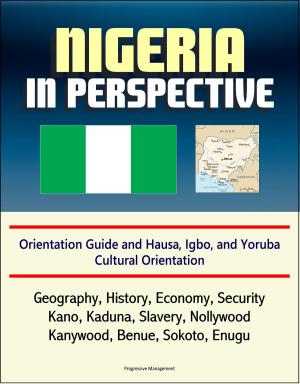Are We Prepared? Four WMD Crises That Could Transform U.S. Security: Failed WMD-armed State, Collapse of Nonproliferation Regime, Biological Terror Campaign, Nuclear Detonation in American City
Nonfiction, History, Military, Nuclear Warfare, Social & Cultural Studies, Political Science| Author: | Progressive Management | ISBN: | 9781311127334 |
| Publisher: | Progressive Management | Publication: | February 4, 2016 |
| Imprint: | Smashwords Edition | Language: | English |
| Author: | Progressive Management |
| ISBN: | 9781311127334 |
| Publisher: | Progressive Management |
| Publication: | February 4, 2016 |
| Imprint: | Smashwords Edition |
| Language: | English |
Professionally converted for accurate flowing-text e-book format reproduction, this report presents four weapons of mass destruction (WMD)-related scenarios that could plausibly occur and radically alter American domestic and national security agendas. Moreover, these scenarios, for which the United States is underprepared, portray challenges that the United States will not overcome shortly. Developing, institutionalizing, and supporting those policies, capabilities, and technologies to successfully overcome these challenges in all likelihood will take years. Consequently, we believe that this paper will continue to have relevance to policymakers, warfighters, responders, and the larger combating WMD community over the coming decade. For this reason, the Center for the Study of Weapons of Mass Destruction has chosen to publish this report for a wider audience. We believe that the challenges, concepts, and recommended solutions herein will provide insight to students and practitioners alike.
The four scenarios: the United States and its allies have begun to fear the imminent collapse of the nonproliferation regime * a state known to possess a nuclear weapons capability and suspected of possessing both chemical and biological weapons programs stands on the brink of political collapse * analysis of samples from multiple BioWatch sensors has identified a large-scale release of aerosolized anthrax on the National Mall * witnesses have reported a blinding flash and mushroom cloud in the seaport area of a major U.S. city.
Taken together, these scenarios demonstrate the complex, multifaceted nature of the WMD challenge for American decisionmakers and illustrate the demands that such events could place on the entire apparatus of government, alliances, and the American people. Our findings are drawn from ongoing research conducted at the National Defense University's Center for the Study of Weapons of Mass Destruction and reflect nonpartisan perspectives and conclusions drawn from extensive interactions with scores of former and serving senior U.S. officials and nationally recognized subject matter experts. This introductory section presents findings and recommendations suitable for senior civilian and military leaders whose responsibilities include different aspects of the WMD challenge and require them to integrate their departments' activities with those of other departments and foreign governments to prevent proliferation, protect against the effects of proliferation, or respond to the consequences of WMD use. It also describes the present and evolving WMD threat, reviews first principles in combating WMD, and emphasizes the need to act decisively to meet today's challenges.
In recent years the U.S. Government has made considerable strides in preparing for individual aspects of such crises. New interdiction processes and activities have improved our ability to track proliferation-related activities and prepare to stop them. High-value programs are leveraging Cold War technologies to enhance the Nation's nuclear and biological forensics capabilities. Various nuclear and biological detection programs at home and at key ports and facilities abroad have enhanced our ability to stop the smuggling and transfer of WMD capabilities and improved our ability to detect and defend against WMD terrorism at home. As the number of WMD-related programs and activities has grown, however, the mechanisms necessary to coordinate and synchronize responses, adjudicate priorities, and allocate resources across the government have failed to keep pace.
Professionally converted for accurate flowing-text e-book format reproduction, this report presents four weapons of mass destruction (WMD)-related scenarios that could plausibly occur and radically alter American domestic and national security agendas. Moreover, these scenarios, for which the United States is underprepared, portray challenges that the United States will not overcome shortly. Developing, institutionalizing, and supporting those policies, capabilities, and technologies to successfully overcome these challenges in all likelihood will take years. Consequently, we believe that this paper will continue to have relevance to policymakers, warfighters, responders, and the larger combating WMD community over the coming decade. For this reason, the Center for the Study of Weapons of Mass Destruction has chosen to publish this report for a wider audience. We believe that the challenges, concepts, and recommended solutions herein will provide insight to students and practitioners alike.
The four scenarios: the United States and its allies have begun to fear the imminent collapse of the nonproliferation regime * a state known to possess a nuclear weapons capability and suspected of possessing both chemical and biological weapons programs stands on the brink of political collapse * analysis of samples from multiple BioWatch sensors has identified a large-scale release of aerosolized anthrax on the National Mall * witnesses have reported a blinding flash and mushroom cloud in the seaport area of a major U.S. city.
Taken together, these scenarios demonstrate the complex, multifaceted nature of the WMD challenge for American decisionmakers and illustrate the demands that such events could place on the entire apparatus of government, alliances, and the American people. Our findings are drawn from ongoing research conducted at the National Defense University's Center for the Study of Weapons of Mass Destruction and reflect nonpartisan perspectives and conclusions drawn from extensive interactions with scores of former and serving senior U.S. officials and nationally recognized subject matter experts. This introductory section presents findings and recommendations suitable for senior civilian and military leaders whose responsibilities include different aspects of the WMD challenge and require them to integrate their departments' activities with those of other departments and foreign governments to prevent proliferation, protect against the effects of proliferation, or respond to the consequences of WMD use. It also describes the present and evolving WMD threat, reviews first principles in combating WMD, and emphasizes the need to act decisively to meet today's challenges.
In recent years the U.S. Government has made considerable strides in preparing for individual aspects of such crises. New interdiction processes and activities have improved our ability to track proliferation-related activities and prepare to stop them. High-value programs are leveraging Cold War technologies to enhance the Nation's nuclear and biological forensics capabilities. Various nuclear and biological detection programs at home and at key ports and facilities abroad have enhanced our ability to stop the smuggling and transfer of WMD capabilities and improved our ability to detect and defend against WMD terrorism at home. As the number of WMD-related programs and activities has grown, however, the mechanisms necessary to coordinate and synchronize responses, adjudicate priorities, and allocate resources across the government have failed to keep pace.















